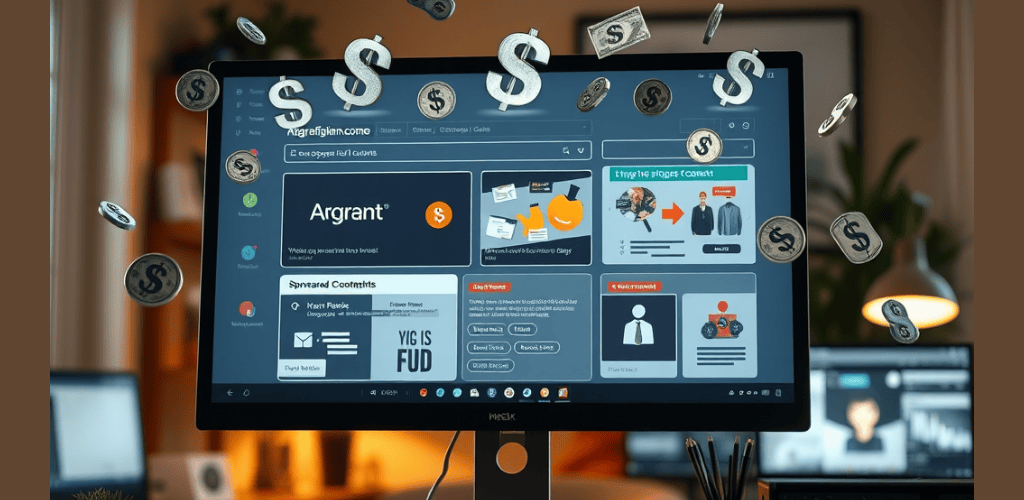Are you tired of pouring your heart and soul into your blog without seeing any financial returns? You’re not alone. Many aspiring bloggers dream of turning their passion into profit, but struggle to make it a reality. The good news? Transforming your blog into a money-making machine is not only possible, but achievable with the right strategies.
Imagine waking up to find your blog has generated hundreds, even thousands of dollars while you slept. This isn’t just a fantasy – it’s the reality for successful bloggers who’ve cracked the code on monetization. From choosing a profitable niche to implementing diverse income streams, there’s a world of opportunities waiting for you to explore. Whether you’re a new blogger or looking to take your existing site to the next level, this guide will reveal the secrets to How to Make Money from a Blog Website.
Ready to turn your blog into a thriving business? Let’s dive into the essential steps you need to take, from creating high-quality content that keeps readers coming back for more, to optimizing your site for maximum conversions. We’ll explore proven monetization strategies, discuss the best blogging platforms for writers, and even touch on how to monetize a WordPress blog. Get ready to transform your passion project into a profitable venture!
Table of Contents
- Choose A Profitable Niche for a blogging platform
- Create High-Quality Content
- Build A Loyal Audience
- Implement Monetization Strategies
- Optimize Your Blog For Conversions
- Diversify Income Streams
- Scale Your Blog Business
- Free Blogging Platforms
- Which Blogging Platform Is Best For Writers
- Blogging Platforms Examples
- How To Monetize WordPress Blog
Choose A Profitable Niche for a blogging platform

A. Research popular blog topics
To choose a profitable niche, it’s crucial to start by researching popular blog topics. This step will help you identify areas with high demand and potential for monetization. Here are some of the most profitable niches for 2024:
- Digital marketing
- Tech and AI
- Blogging and making money online
- Health and fitness
- Personal finance and investing
- Recipes and food
- Personal development and self-care
These niches offer various opportunities for content creation and monetization strategies. For example, the digital marketing niche is projected to reach $807.92 billion by 2028, while the AI market is expected to hit $407 billion by 2027.
B. Identify your target audience
Once you’ve explored popular topics, it’s essential to identify your target audience. This will help you tailor your content and monetization strategies to their specific needs and interests. Consider factors such as:
- Age range
- Gender
- Income level
- Education
- Interests and hobbies
Understanding your audience will allow you to create content that resonates with them and increases your chances of success.
C. Analyze market demand
Analyzing market demand is crucial for determining the potential profitability of your chosen niche. Here’s a comparison of market demand for some popular niches:
| Niche | Market Size | Growth Potential |
|---|---|---|
| Digital Marketing | $807.92 billion by 2028 | High |
| Tech and AI | $407 billion by 2027 | Very High |
| Online Fitness | $76.6 billion by 2027 | Moderate |
| Personal Finance | Growing steadily | High |
| Food and Recipes | Evergreen | Stable |
D. Assess competition
Finally, assess the competition in your chosen niche. While some competition is healthy, you want to avoid oversaturated markets. Look for:
- Number of existing blogs in the niche
- Quality of content from competitors
- Monetization strategies used by successful blogs
- Opportunities for differentiation
By thoroughly researching popular topics, identifying your target audience, analyzing market demand, and assessing competition, you’ll be well-positioned to choose a profitable niche for your blog.
Now that we have covered how to choose a profitable niche, let’s move on to the next crucial step: creating high-quality content. This is essential for attracting and retaining your audience, as well as establishing your authority in your chosen niche.
Create High-Quality Content

Now that we’ve chosen a profitable niche, let’s focus on creating high-quality content that will attract and retain readers.
Develop a content strategy like “How to make money from a blog website“
To create a successful blog, it’s essential to have a well-planned content strategy. This involves:
- Identifying your target audience
- Determining the types of content that resonate with them
- Creating a content calendar to maintain consistency
| Content Type | Purpose | Example |
|---|---|---|
| How-to guides | Provide practical value | “How to Monetize a WordPress Blog” |
| Product reviews | Offer insights on tools | “Best Blogging Platforms for Writers” |
| Industry news | Keep readers informed | “Latest Updates in Free Blogging Platforms” |
Write engaging and informative posts
When crafting your blog posts, focus on delivering value to your readers. Here are some tips:
- Use clear, concise language
- Break up text with subheadings and bullet points
- Include relevant examples and case studies
- Address common questions and pain points
Optimize for SEO
To improve your blog’s visibility in search engines, consider these SEO best practices:
- Research and incorporate relevant keywords naturally
- Optimize your meta titles and descriptions
- Use header tags (H1, H2, H3) to structure your content
- Include internal and external links where appropriate
Incorporate visuals and multimedia
Enhance your blog posts with visual elements to make them more engaging:
- Add high-quality images and infographics
- Embed relevant videos or podcasts
- Create custom graphics to illustrate key points
By following these strategies, you’ll be well on your way to creating high-quality content that attracts and retains readers. In the next section, we’ll explore how to build a loyal audience for your blog.
Build A Loyal Audience

Now that we’ve covered creating high-quality content, let’s focus on building a loyal audience for your blog. This step is crucial for transforming your blog into a successful platform that can generate income.
A. Promote your blog on social media
Social media is a powerful tool for expanding your blog’s reach. Share your blog posts automatically on key platforms to increase visibility and attract new readers. Monitor social media for relevant discussions and participate in online communities to establish your presence and expertise.
B. Engage with readers through comments
Fostering a sense of community is essential for building a loyal audience. Respond promptly to comments on your blog and engage in meaningful discussions. This approach not only encourages repeat visits but also helps create a vibrant community around your content.
C. Guest post on other blogs
Guest blogging is an effective strategy for reaching new audiences and establishing your authority in your niche. Focus on high-engagement platforms and follow these steps:
- Connect with blog owners in your niche
- Pitch value-added content ideas
- Create high-quality guest posts
- Promote your guest posts effectively
D. Collaborate with influencers
Partnering with influencers can significantly boost your blog’s visibility and credibility. Consider these collaboration opportunities:
| Collaboration Type | Benefits |
|---|---|
| Expert roundups | Gain insights and expand reach |
| Co-hosted webinars | Share audiences and expertise |
| Podcast appearances | Reach new listeners and build authority |
E. Start an email newsletter
Email marketing remains one of the most effective ways to retain readers and build a loyal audience. Implement these strategies:
- Offer incentives for subscribers (e.g., exclusive content, free resources)
- Use dedicated landing pages for sign-ups
- Strategically place opt-in forms throughout your blog
- Provide valuable content in your newsletters
By consistently implementing these strategies, you’ll be well on your way to building a loyal audience for your blog. With a strong reader base in place, you’ll be better positioned to implement monetization strategies, which we’ll explore in the next section.
Implement Monetization Strategies

Now that we’ve built a loyal audience, it’s time to implement monetization strategies to turn your blog into a profitable venture. Let’s explore various methods to generate income from your blog.
A. Display advertising
Display advertising is a straightforward way to monetize your blog. By partnering with ad networks like Google AdSense, you can display relevant ads on your site. Your earnings are based on clicks or views, making this a passive income stream. However, keep in mind that significant traffic is required for substantial earnings.
B. Affiliate marketing
Affiliate marketing involves promoting products or services and earning a commission on resulting sales. Here’s a quick overview:
| Aspect | Description |
|---|---|
| Process | Share unique affiliate links in your content |
| Earnings | Commissions on sales generated through your links |
| Disclosure | FTC requires clear disclosure of affiliate relationships |
| Popular programs | Amazon Associates, CJ Affiliate, Upwork Affiliates |
Choose affiliate partnerships that align with your niche and audience interests for best results.
C. Sponsored content
As your blog grows, companies may pay you to write about their products or services. This can be lucrative, especially if you have a sizable following. Ensure sponsored content aligns with your niche and clearly disclose partnerships to maintain trust with your audience.
D. Digital products and courses
Leverage your expertise by creating and selling:
- E-books
- Online courses
- Webinars
- Podcasts
These products allow you to share your knowledge while generating income. They’re particularly effective if you’ve established yourself as an expert in your field.
E. Coaching and consulting services
Offer personalized assistance to your audience through:
- One-on-one coaching sessions
- Group consultations
- Freelance writing services
- Niche-specific consulting
This strategy works well for bloggers who have developed a strong reputation in their industry.
With these monetization strategies in place, it’s crucial to optimize your blog for conversions. This will ensure that your efforts in implementing these income streams are as effective as possible
Optimize Your Blog For Conversions

Now that we’ve covered how to implement monetization strategies, let’s focus on optimizing your blog for conversions. This crucial step will help you maximize the effectiveness of your monetization efforts.
Design a user-friendly layout
A well-designed blog layout is essential for keeping visitors engaged and guiding them towards desired actions. Consider implementing heat mapping tools to analyze user behavior and inform your design decisions. Prioritize a mobile-first approach, ensuring your blog is easily navigable on all devices.
Create compelling calls-to-action (CTAs)
Effective CTAs are vital for driving conversions. Here are some tips for optimizing your CTAs:
- Use action-oriented language
- Make them visually distinctive
- Place them strategically throughout your content
- A/B test different CTA designs and placements
Implement email capture forms
Email marketing remains a powerful tool for bloggers. To build your email list:
- Place forms in high-visibility areas
- Offer incentives for sign-ups
- Keep forms simple and user-friendly
- Test different form designs and placements
Offer lead magnets
Lead magnets are valuable resources offered in exchange for contact information. Here are some effective lead magnet ideas:
| Lead Magnet Type | Description |
|---|---|
| eBooks | In-depth guides on your niche topics |
| Checklists | Actionable, easy-to-use resources |
| Templates | Customizable tools for your audience |
| Exclusive content | Gated articles or videos |
Remember, the key to successful conversion optimization is continuous testing and adaptation. Use the PIE framework (Potential, Importance, Ease) to prioritize your optimization efforts and focus on changes that will have the most significant impact.
With these optimization strategies in place, you’ll be well-positioned to diversify your income streams, which we’ll explore in the next section.
Diversify Income Streams

Now that we’ve optimized our blog for conversions, it’s crucial to diversify our income streams to ensure long-term sustainability and growth. By expanding our revenue sources, we can create a more stable financial foundation for our blogging business.
A. Create and sell e-books
E-books are an excellent way to monetize your expertise and provide value to your audience. As mentioned in the reference content, digital products like e-books offer scalable income opportunities. To create a successful e-book:
- Choose a topic that aligns with your blog’s niche
- Research and outline your content
- Write and edit your e-book
- Design an attractive cover
- Set up a sales funnel for your e-book
B. Host webinars and workshops
Webinars and workshops allow you to share your knowledge interactively while generating income. Consider the following steps:
- Select a topic that addresses your audience’s pain points
- Create engaging presentation materials
- Choose a reliable webinar platform
- Promote your event through your blog and social media
- Offer exclusive bonuses or discounts to attendees
C. Offer membership programs
Membership programs provide recurring revenue and foster a sense of community among your readers. To implement a successful membership program:
| Feature | Benefits |
|---|---|
| Exclusive content | Incentivizes subscriptions |
| Community access | Increases engagement |
| Regular updates | Encourages retention |
| Tiered pricing | Caters to different audience segments |
D. Develop physical products
While digital products are popular, physical merchandise can also be a lucrative income stream. Consider these options:
- Branded merchandise (e.g., t-shirts, mugs)
- Books or printed materials
- Niche-specific products related to your blog’s topic
To get started with physical products:
- Research potential manufacturers or dropshipping partners
- Design your products or collaborate with designers
- Set up an e-commerce platform on your blog
- Create compelling product descriptions and images
- Implement a marketing strategy to promote your products
By diversifying your income streams, you’ll be better positioned to weather fluctuations in advertiser demand and create a more robust blogging business. With these strategies in place, we can now look at scaling your blog business to reach new heights and maximize your earning potential.
Scale Your Blog Business

Now that we’ve covered how to diversify your income streams, let’s explore how to scale your blog business for even greater success.
A. Outsource content creation
As your blog grows, maintaining a consistent content output can become challenging. Outsourcing content creation allows you to focus on strategic tasks while ensuring a steady flow of high-quality articles. Consider:
- Hiring writers for initial drafts
- Engaging assistants for link building
- Documenting processes in a Standard Operating Procedure (SOP) folder
| Task | Benefits |
|---|---|
| Hiring writers | Increased content output, diverse perspectives |
| Link building assistants | Improved SEO, more time for relationship building |
| SOP documentation | Consistency, easier onboarding for new team members |
B. Invest in paid advertising
To accelerate your blog’s growth, consider allocating resources to paid advertising. This strategy can help you:
- Reach a wider audience
- Drive targeted traffic to your blog
- Promote specific content or products
C. Expand to multiple websites
Scaling your blog business may involve expanding beyond a single website. Consider:
- Launching niche-specific sites
- Creating a network of interconnected blogs
- Diversifying your online presence
D. Explore partnerships and joint ventures
Collaborating with other bloggers or businesses can significantly boost your reach and revenue. Look for opportunities to:
- Co-create content
- Cross-promote products or services
- Participate in affiliate partnerships
Remember to maintain a balance between quantity and quality as you scale. Utilize productivity tools like Bramework for content creation and Canva for graphic design to streamline your workflows.
By implementing these scaling strategies, you’ll be well-positioned to grow your blog into a thriving business. As we move forward, we’ll explore free blogging platforms that can help you get started on your blogging journey without significant upfront costs.
Free Blogging Platforms

Now that we’ve explored how to scale your blog business, let’s delve into the world of free blogging platforms. These platforms can be an excellent starting point for aspiring bloggers who want to test the waters before investing in paid options.
Free Blog Sites
Free blogging platforms offer an accessible entry point for new bloggers, providing essential tools to create and manage content without upfront costs. However, it’s important to note that these platforms often come with limitations that may impact your ability to monetize and customize your blog.
Here’s a comparison of some popular free blogging platforms:
| Platform | Strengths | Limitations |
|---|---|---|
| WordPress.com | User-friendly, extensive customization | Limited monetization options on free plan |
| Blogger | Simple interface, AdSense integration | Limited design options, Google ownership |
| Medium | Built-in audience, clean interface | Limited customization, restricted monetization |
| Tumblr | Diverse content sharing, community features | Limited design customization |
| Write.as | Minimalist design, privacy-focused | Limited features on free plan |
When considering free blogging platforms, keep in mind:
- Content ownership: Some platforms may have rights to your content.
- Monetization restrictions: Free plans often limit your ability to earn revenue.
- Customization options: Design and functionality may be limited.
- Domain limitations: You may be restricted to a subdomain of the platform.
While free platforms can help you start your blogging journey, they may not be suitable for long-term growth and monetization. As your blog gains traction, you might consider transitioning to a self-hosted solution like WordPress.org, which offers greater control and flexibility.
With this overview of free blogging platforms in mind, next, we’ll explore which blogging platform is best for writers, considering factors such as ease of use, content ownership, and monetization potential.
Which Blogging Platform Is Best For Writers

Now that we have explored free blogging platforms, let’s delve into which blogging platform is best for writers, focusing on the top options available.
A. Best Blogging Platform
When it comes to selecting the ideal blogging platform for writers, several factors come into play, including customization options, monetization potential, and ease of use. Based on the reference content, here’s a comparison of some of the best blogging platforms for writers:
| Platform | Strengths | Weaknesses | Best For |
|---|---|---|---|
| WordPress.org | Most flexible, full control over content and monetization | Requires domain and hosting costs | Serious bloggers and businesses |
| Medium | User-friendly, built-in audience | Limited monetization, less content control | Testing ideas, reaching new audiences |
| Ghost | Minimalist design, content-focused | Lacks e-commerce capabilities | Writers prioritizing clean interface |
| Wix | User-friendly drag-and-drop interface, built-in SEO tools | Limited backend control | Beginners seeking easy design options |
| Substack | Combines blogging with newsletter functionality | Minimal design options | Writers focused on direct audience engagement |
Among these options, WordPress.org stands out as the most versatile and scalable platform for writers. It offers:
- Complete control over content and monetization methods
- Extensive customization options
- Wide range of third-party app integrations
- Suitability for both hobbyists and serious business owners
However, it’s important to note that WordPress.org requires more technical knowledge and additional costs for hosting and domain registration.
For writers looking for a simpler solution, platforms like Medium or Ghost provide a more streamlined experience. Medium offers a built-in audience and some monetization options, while Ghost focuses on a clean, distraction-free writing environment.
Factors to consider when choosing a blogging platform include:
- Ease of use
- Customization options
- Monetization potential
- SEO capabilities
- Audience reach
- Cost and scalability
Ultimately, the best blogging platform for a writer depends on their specific needs, technical skills, and long-term goals. It’s crucial to evaluate these factors carefully before making a decision.
With this understanding of the best blogging platforms for writers, let’s move on to explore some specific examples of blogging platforms in the next section, which will provide a more detailed look at the options available in the market.
Blogging Platforms Examples

Now that we’ve explored which blogging platform is best for writers, let’s dive into some specific examples of popular blogging platforms. These platforms offer a range of features and capabilities to suit different blogging needs and styles.
Popular Blogging Platforms
WordPress
WordPress remains the most versatile and widely-used blogging platform, powering 43% of all websites. It offers two versions:
- WordPress.org (self-hosted):
- Highly flexible and scalable
- Full control over content and monetization
- Requires domain and hosting costs
- Extensive customization options
- Highly flexible and scalable
- WordPress.com (hosted):
- User-friendly setup for beginners
- Limited monetization and customization compared to self-hosted version
- User-friendly setup for beginners
Medium
- Free and simple blogging experience
- Ideal for testing ideas
- Limited monetization and content ownership
Squarespace
- Professional templates and easy customization
- Higher costs
- Limited flexibility compared to WordPress
Wix
- User-friendly drag-and-drop interface
- Built-in SEO tools
- Limited backend control and ad revenue options
Comparison of Blogging Platforms
| Platform | Ease of Use | Customization | Monetization | Cost |
|---|---|---|---|---|
| WordPress.org | Moderate | High | High | Low to Moderate |
| Medium | High | Low | Low | Free |
| Squarespace | High | Moderate | Moderate | High |
| Wix | High | Moderate | Moderate | Moderate |
Other Notable Platforms
- Ghost: Minimalist blogging with content control
- Blogger: Simple, Google-owned platform with AdSense integration
- Tumblr: Diverse content sharing with limited design customization
- HubPages: Revenue-sharing model with more monetization options than Medium
Each platform offers unique features and trade-offs, catering to different blogging needs and expertise levels. When choosing a platform, consider factors such as ease of use, customization options, monetization potential, and associated costs.
With these blogging platform examples in mind, next, we’ll explore how to monetize a WordPress blog, which is particularly relevant given WordPress’s popularity and extensive monetization capabilities.
How To Monetize WordPress Blog

Now that we have explored various blogging platforms, let’s dive into how to monetize a WordPress blog specifically. WordPress is a popular choice for many bloggers, and understanding how to generate income from your WordPress site is crucial for turning your passion into a profitable venture.
Monetization Strategies for WordPress Blogs
Advertising
One of the most common ways to monetize a WordPress blog is through advertising. There are two primary payment models:
- Pay-per-click (PPC): Earn revenue when users click on ads
- Pay-per-impression (PPI): Earn based on ad views
Google AdSense is a leading ad network due to its user-friendly interface and competitive profit-sharing model. However, be cautious of ad clutter, which can diminish user trust and engagement.
Affiliate Marketing
Affiliate marketing is a user-friendly and potentially lucrative option. Here’s how it works:
- Promote third-party products through special affiliate links
- Earn commissions on sales generated through your links
- Amazon Associates is a major player, but numerous other programs exist
| Affiliate Marketing Tips |
|---|
| Promote products you genuinely enjoy |
| Build an audience before linking to products |
| Maintain authenticity in recommendations |
Sponsored Blog Posts
Established writers can earn more by reviewing or mentioning brands’ products. This strategy requires:
- Outreach to brands for sponsorship opportunities
- Maintaining authenticity in recommendations
- Preserving readership trust
Selling Exclusive Content
Create additional value by offering:
- Premium insights through exclusive posts
- Printables
- Ebooks
- Online courses
Other Monetization Methods
- Merchandise sales
- Membership websites with gated content
- Soliciting donations (less reliable but low-effort)
Tools for WordPress Monetization
To implement these strategies effectively, consider using:
- ThirstyAffiliates or AffiliateWP for affiliate link management
- WordPress Download Manager for selling digital products
- LearnPress for creating and managing online courses
Remember, successful monetization requires a dedicated audience and strong content. Focus on delivering value to your readers consistently, and over time, your WordPress blog can become a sustainable income source.
Blogging has evolved from a mere hobby to a potentially lucrative career path. By choosing a profitable niche, creating high-quality content, and building a loyal audience, you can lay the foundation for a successful blog. Implementing diverse monetization strategies, such as affiliate marketing, sponsored content, and digital products, allows you to maximize your earning potential. Remember, optimizing your blog for conversions and continuously scaling your business are crucial steps in turning your passion into profit.
While success doesn’t happen overnight, with dedication, consistency, and strategic planning, you can transform your blog into a sustainable income source. Whether you’re using free blogging platforms or paid options, focus on providing value to your readers and adapting to industry trends. By diversifying your income streams and leveraging various content formats, you’ll be well-positioned to thrive in the competitive world of blogging. Start your journey today, and with patience and perseverance, you could be on your way to earning a full-time income from your blog.







